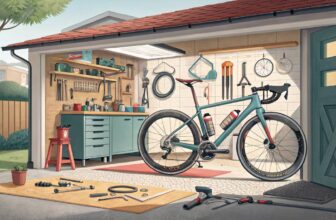Identifying Fake Reviews
Understanding the Impact
Fake reviews are like those flashy neon signs you see in a window—at times, beguiling, yet rarely telling the full story. They can mess with our heads and lead to decisions that resemble a bad blind date. Picture this: you’re buying a bike having read glowing reviews, only to find it’s as creaky as an old ship.
According to a study from the Journal of Retailing and Consumer Services, shoppers heavily rely on reviews when picking out bikes. It’s crucial to separate the gushing truth from the calculated counterfeit.
Fake reviews aren’t just trolling individual shoppers—they’re shaking the whole shopping scene. Legit brands lose out to sneaky folks using phony feedback to up their sales. Plus, buying based on bogus reviews could lead to unsafe products and wasted cash. This hits hard for pennywise planners and budget-savvy shoppers hunting for the best deals.
Identifying Red Flags
To sniff out fake reviews, folks need to be like detectives in a crime show. Spot these tell-tale signs:
- Overly Positive Reviews: If reviews sound like they’re written by the bike’s PR team, beware. Real reviews often include both “yay” and “nay”.
- Reviewer Patterns: Be wary of one person dropping glowing reviews like confetti or users with zero prior activity suddenly buzzing.
- Repetitive Content: Review-text cloning is a red alert. If reviews look like they’ve been copied, they probably have.
- Unverified Purchases: Trust reviews from people who haven’t even bought the thing? Nah, skip those.
- Lack of Detail: Vague reviews are as useless as a chocolate teapot. Authentic ones spill the beans on performance specifics.
| Red Flag | Description |
|---|---|
| Overly Positive Reviews | All sunshine without a cloud. |
| Reviewer Patterns | Reviews dropping like flies from the same person. |
| Repetitive Content | Parrot-like text across the board. |
| Unverified Purchases | Reviews from non-buyers. |
| Lack of Detail | All fluff, no substance. |
Ready to outsmart phony reviews? Our detailed bike review research guide is packed with insights to spot the genuine ones.
Whether you’re deep diving into brand particulars, lining up bike features, or pinching pennies, zeroing in on fake reviews will shield you from saddle sorrows. This way, whether your wheels are fresh from the factory or pre-loved, they’ll roll out backed by honest feedback.
The Rise of Counterfeit Goods
Fake bike reviews and counterfeit goods are a total headache for the cycling community nowadays. Folks are having a tough time telling the real stuff from the fakes. Let’s dig into how this counterfeit mess is messing with your buying experience.
Overview of Counterfeiting Trends
Counterfeit goods are everywhere these days, and bikes aren’t immune. Sneaky sellers are knocking off popular bike brands, creating replicas that look almost real. To make things trickier, they sprinkle in bogus reviews to trick folks into buying these phony goods.
As online shopping grows, it’s like a counterfeit party. Websites are popping up, pretending to be the real deal, and they’re convincing. Fake sites even copy big names like Schwalbe and DMR Bikes to fool buyers into thinking they’re legit.
Key Trends
- Fake reviews tricking folks into buying counterfeits.
- Phony websites pretending to be real bike shops.
- Big brands draw the most counterfeit attention.
- Sneaky sellers use crafty methods to avoid detection.
Impact on Consumers
The boom in fake goods is hitting consumers hard, not just in their wallets, but also risking their necks with unsafe products.
Consumer Risks
| Risk | What’s at Stake |
|---|---|
| Financial Loss | Your money’s gone with zero return if you get a dud. |
| Safety Concerns | Higher chance the product fails, which can lead to nasty spills. |
| Deceptive Marketing | Hoodwinked by fake reviews and sham websites. |
| Limited Recourse | Good luck getting your money back or taking legal action. |
With fake bikes around every corner, it’s hard to trust online stores or brands anymore. But don’t sweat it. Stick to buying from reputable sources, make sure you check the brand is genuine, and stay smart about what you’re buying. You can go through our resources on smart buying tips and the risks of counterfeits.
Keep your bookmarks updated with trusted sellers and get the lowdown on things like checking your bike’s serial number, so you don’t end up with junk. Knowledge is power, right?
For a heads-up on where to find legit bikes, check out our guides on buying them and understanding your bike’s warranty. Stay informed, and keep your bike and wallet safe!
Strategies for Spotting Fake Products
Alright, so you’re hunting for a new bike, and you want the real deal, not some back alley knockoff that’s gonna collapse like a deck of cards. Here’s how you can spot the fakes and pedal away with confidence.
Brand Verification Tips
First things first, trust but verify, right? Let’s get into some down-to-earth brand checks:
- Official Retailers: Stick to buying from the folks on the brand’s ‘friend list.’ Check their website for the list of approved sellers. No sketchy street deals here, please.
- Check Serial Numbers: Each bike should have its own little fingerprint, AKA a serial number. Head over to the brand’s site or give their customer service a holler for confirmation. We’ve even got a handy tool for that.
- Investigate Reviews: Watch out for those too-good-to-be-true reviews—y’know, the ones that read like they were written by robots. Snooping around multiple review sites often reveals the truth.
- Brand Websites: Compare the bike’s details on the brand’s official site. If specs don’t add up or color schemes look off, you might be looking at a fake.
Quality Control Checks
Let’s talk quality. These are the nitty-gritty checks that keep you from rolling on a subpar ride:
| Checkpoint | Description |
|---|---|
| Material Quality | Real bikes have that smooth, high-quality finish on the frames and parts. No flaky paint or cheap plastic here. |
| Brand Markings | Scope out the logos. If the font’s funky or the emblem’s misplaced, that’s a huge red flag. |
| Component Consistency | Your legit ride comes with matching parts from legit brands. Compare stuff with our components list. |
| Assembly Quality | Genuine bikes are put together with love. Check for seamless welds and paint with no weird streaks. |
| Performance Tests: Take that bike for a spin. A genuine article feels like freedom—smooth, stable, and just plain right. See our testing guide for a full breakdown. |
Internal Links Examples
- Want to know where to buy bikes safely? We’ve got you.
- Need insights on bike warranties for fakes? We’ve got that covered too.
- Use our bike size calculator for the perfect ride—counterfeits won’t measure up.
By checking these points and doing a little homework, you’ll dodge those fake bikes like a pro. Bagging an authentic bike means you’ll ride easily, knowing your bike’s safe and built to last. For more on fighting the counterfeit plague, peek into our Legal Battle Against Counterfeiting section.
Anti-Counterfeit Efforts in the Bike Industry
Navigating the minefield of fake bike reviews and knock-off cycling gear is no joke. Consumers need to know the lengths companies go to in their battle against these tricksters.
Specialized’s Anti-Counterfeit Initiatives
Specialized is waving the largest banner in the fight against dubious bike products. Andrew Love heads up their top-notch investigation team, which is as solid as they come in this field.
Here’s how they play hardball:
- Takedown Notices: They’re sending takedown notices left, right, and center to wipe out fake listings online. But those pesky counterfeiters are slippery, sidestepping by wiping out brand names or using sneaky image tricks to cover logos.
- Working with the Law: Specialized teams up with the cops to track down fake products and bust the networks behind them.
- Following the Money: Digging deep into the financial dealings of counterfeit sellers until their shady businesses crumble.
While you’re brushing up on spotting pretenders, our bike price guide and compare bike specs sections might just be your new best friend.
Collaborative Industry Actions
The bike industry is coming together like a well-oiled machine to tackle this counterfeit conundrum, roping in everyone from manufacturers to retailers.
- Joining Forces: They’re sharing intel about the fakes, making those takedown warnings as mighty as Thor’s hammer, and coordinating raids with law enforcement.
- Knowledge is Power: Running campaigns to clue in consumers about the downsides of counterfeits and the advantages of shopping from legitimate sources.
- Tech Savvy Moves: Rolling out tech the way Iron Man does, using serial numbers, QR codes, and even blockchain to stamp out fakes and confirm legit products.
Brands mucking in here make life easier and safer for all of us pedal-pushers. If you’re hunting for genuine bike gear, don’t miss our best bike brands and find out where to buy bikes.
Table: How Big Bike Brands Battle Fakes
| Brand | Key Moves | Tips for Shoppers |
|---|---|---|
| Specialized | Leading in-house anti-fake squad, takes down guff listings, law enforcer pals, tracks and thwarts money trails | Teach yourself how to spot real sellers, don’t get punked by phony goods |
| Major Brands | Group intel-sharing, info sessions, tech tactics | Lean on new tech for real-deal checks, stick to legit retailers |
These collective thrusts against fakes give buyers a clearer path to make wise choices. For more on steering clear of phonies, peek at our fake bike reviews piece, loaded with extra insight and savvy buying tips.
The Legal Battle Against Counterfeiting
The global market for knock-offs is no joke. It’s a sneaky problem we’ve got, and it’s messing with all sorts of industries—including the bike world. Believe it or not, fake products make up around 3.3% of trade across the globe (New York Times). This here section talks about the hustle to squash fake bike stuff through legal action and gives a nod to some wins.
Legal Actions Taken
How do you tackle all this fakery in bike gear? Well, folks have been rolling up their sleeves for a while now. In particular, the big guns at the US Department of Homeland Security have been on it. The amount of counterfeit stuff they’ve nabbed has shot up by more than three times in the last ten years, with last year’s haul hitting the $1.2 billion mark. These busts have stopped a load of bogus goods from hitting our doorsteps.
Big online shops, like Amazon, have gotten their fair share of heat. They’ve been hustling to zap fake listings, though crooks are getting slicker, dodging these efforts by skipping out on brand names or using cheeky software tricks to hide logos in posts (Bicycling).
Successes in Combatting Counterfeits
All these legal moves have racked up some sweet victories against the fakers. Big takedowns have shut down loads of fake operations and cleaned up online marketplaces from junk products. A mash-up of efforts from brand warriors and the law has scored big in cleaning up the scene and making shopping a little less sketchy.
| Year | Counterfeit Seizures (Value in $) | Increase from Previous Year (%) |
|---|---|---|
| 2010 | $300 million | N/A |
| 2015 | $800 million | 166% |
| Last Year | $1.2 billion | 50% |
Staying on your toes and keeping consumers clued in is crucial if we want to keep fake markets at bay. Team efforts and sharp eyes are what help keep the wins coming.
For all you bike fans and newbies, knowing bike price tracking, where to buy bikes, and doing some solid bike review research can mean the difference between a real deal and a phony. There are more tools in the toolbox, like the bike warranty guide and bike component comparison, giving you the backup to protect your investment.
With everyone from lawyers to bike riders digging in their heels, the push to bust counterfeit bike products rolls on, making the biking world a safer ride.
Risks and Dangers of Fake Bike Products
Buying fake bike gear is like playing with fire—it can burn you in more ways than one. Let’s break down the risks that can mess up your wallet and, more importantly, your safety.
Safety Concerns
Knockoff bike parts cut corners, skipping out on important safety checks that keep you (and your bike) in one piece. Imagine zipping down a hill only to find out your brakes are about as reliable as a weather forecast. Is your frame cracking under pressure because it was built with cheaper materials? Not cool. And helmets that might as well be decorative hats because they’ve never seen a proper impact test.
| Category | Example | Risk |
|---|---|---|
| Frames | Carbon fiber wannabes | Structural collapse |
| Brakes | Low-grade metals | Brake mishaps |
| Helmets | No drop tests ding ding | Head injuries |
| Tires | Second-rate rubber | Blowouts |
Fake products are sneaky infiltrators, making up 3.3% of stuff traded around the globe. In the US, Homeland Security has had its hands full, dealing with a 300% spike in seizures of fake goods lately, according to Bicycling. The whole situation isn’t just about bikes—it stretches to dangers like electric shocks and allergic reactions.
Potential Consequences
So, let’s chat about what you might end up dealing with if you fall for counterfeit bike gear:
- Financial Headaches: Think you’re getting a bargain? Not so much. You end up paying for shoddy products that will drain even more cash for fixes or replacements.
- Warranty Woes: Good luck getting a fake product fixed on the cheap. Genuine gear comes with peace-of-mind warranty love—something counterfeit sellers can’t offer.
- Legal Hassles: Buying or selling fake stuff? You could land in a serious pickle. Authorities around the world are cracking down on counterfeiting, and you don’t want to be part of that mess.
- Performance Pitfalls: Counterfeit components don’t perform like the real deal. Your rides could go from smooth and fun to shaky and iffy, putting you at risk.
Want to become a pro at spotting the fakes? Check out our tips on spotting fake products. If you’re wondering how to get the right fit for your bike, hit up our bike frame sizing guide.
These knockoff nightmares are a big, neon sign saying, “Buy from trusted stores!” It’s the only way to ensure your gear’s up to scratch. For more pointers on finding legit retailers and comparing bike specs, dive into our guides on where to buy bikes and compare bike specs.
Reporting and Preventing Counterfeit Purchases
Alright, folks, let’s chat about counterfeit bike products. Not only do these fakes burn a hole in your pocket, but they can also pose some gnarly safety hazards. So let’s arm you with some know-how on avoiding getting duped and what to do if you spot a faker.
Steps to Take Against Fake Products
- Check Out the Seller: Make sure you’re buying from a trustworthy source. Do a bit of detective work—dig through their reviews and compare their site to the legit brand’s website. If something feels fishy, it probably is.
- Give it the Once Over: Watch for dodgy logos, spelling goofs, packaging mess-ups, and shoddy workmanship. Real-deal products tend to have that premium feel with a fine finish.
- Spot the Bargain Trap: If a deal sounds like it’s saving you too much cash, pump the brakes. Cross-check prices on the brand’s official site, and be careful of too steep discounts on posh gear.
- Legitimacy Stamps: High-end brands like to stamp their approval—whether through certification or serial numbers. Double-check these and, if you can, confirm with the manufacturer.
- Secure Payment Only: Stick to payment options that’ve got your back, like credit cards or PayPal. Stay away from wire transfers and sketchy payment routes.
If you’re a newbie in the biking world, swing by our bike buying mistakes guide for more tips.
| Step | Action |
|---|---|
| 1 | Check Out the Seller |
| 2 | Give it the Once Over |
| 3 | Spot the Bargain Trap |
| 4 | Legitimacy Stamps |
| 5 | Secure Payment Only |
Reporting Suspected Counterfeiters
If you stumble upon some dodgy sellers or products, don’t sit on it. Reporting could help keep the biking community counterfeit-free. Here’s what to do:
- Give the Brand a Heads Up: Companies like Specialized have designated teams for sniffing out counterfeit gear. They’ve got your back and will take action if needed.
- Tell the Marketplaces: If the fake’s lurking on sites such as Amazon or eBay, use their resolution centers to blow the whistle. These platforms usually have processes to take rapid action.
- Loop in Law Enforcement: Think it’s serious? Report it to local authorities or agencies, like the US Department of Homeland Security or the Internet Crime Complaint Center. They can do some heavy lifting to bust counterfeit networks.
Stay protected and informed! Peek at our used bike inspection guide for more wisdom.
| Reporting Platform | Contact Method | Description |
|---|---|---|
| Brand Hotlines | Official Websites | Call or email brand-specific teams to report fakes |
| Online Marketplaces | Resolution Centers | Tell on dodgy sellers and let the sites handle it |
| Law Enforcement | Local Authorities, ICCC | For serious stuff, bring in the big guns to crack down on counterfeiters |
By keeping your eyes peeled and acting quickly, we can all help curb counterfeit bike products. And for more pro tips on finding legit bikes, swing by where to buy bikes. Safe riding!
Case Studies: Fake Cycling Websites
Let’s face it, hunting for the perfect bike parts or accessories online can sometimes feel like navigating a minefield. With a surge in phony sites targeting popular bike brands, pedal pushers need to stay sharp. Even brands like Schwalbe and DMR Bikes have had hiccups with these online imposters.
Schwalbe’s Encounters
Schwalbe, a big player in the tire game, recently got snagged by a bunch of fake online shops posing as them (). These copycat sites are slick, pulling the wool over buyers’ eyes with fancy layouts that mirror real Schwalbe pages. People think they’re scoring some primo rubber, but guess what? The goods never show.
What’s Fishy:
- Look-alike Websites: These fakes are masters at imitation, tricking even the eagle-eyed with authentic-looking designs.
- Fake Product Info: Cleverly copied product details make it hard to spot a con.
- Payment Vanish Act: Money goes, products don’t show.
Always double-check where you’re buying. Peek at customer reviews or see if the site’s on an official dealer list. More tips on buying safely are on our guide to online bike shopping.
DMR Bikes’ Experience
Over in the UK, DMR Bikes had their fair share of internet goblins. These fakes popped up on a sketchy site throwing around the DMR name, logo, and even pictures like they owned them (). And those crazy low prices? Yeah, that’s definitely sketchy.
Heads Up for Buyers:
- Too-Good-To-Be-True Deals: Those bargain basement prices are a screaming red flag.
- Unapproved Usage: The brand’s identity was lifted without permission.
- True Site Alert: If you ain’t on dmrbikes.com, hit the brakes!
Before forking over your cash, triple-check the URL and make sure you’re on the real deal site. Don’t forget to browse our bike brand credibility section to arm yourself against fraud.
| Brand | Problem Area | Real Site |
|---|---|---|
| Schwalbe | Duped by Faker Sites | Various official sellers |
| DMR Bikes | Fake Low-Cost Clone Site | dmrbikes.com |
For all the smooth rides and none of the scams, stick with sites you know and trust. More deets on how to spot shady reviews and stay secure online are in our thorough bike review guide.
The Role of Consumers in Combating Counterfeits
Surprising fact: It’s not just up to the cycling companies and the powers-that-be to kick counterfeit products to the curb. Nope, consumers have a massive part to play in sniffing out the fakes. A big chunk of that is learning to spot the difference and picking the right places to shop.
Consumer Awareness
Seems like everyone and their grandma’s got an opinion online, and shoppers are eating it up like candy—93% say these reviews sway what they end up buying (Frontiers in Psychology). That’s why it’s super important for bike buyers to become review detectives, spotting the real talk from the bogus buzz designed to push fakes.
Smart Tips for Spotting Real Reviews:
- Look at Many Reviews: Get the big picture instead of trusting just one lone ranger. Patterns and flow in customer chatter can help reveal the truth.
- Check When They’re Posted: Tons of reviews popping up overnight? Could be a sign of phony baloney.
- Peek at Reviewer Profiles: Check their past. Real deal profiles usually have a mixed bag of reviews.
Given that almost 60% of folks check out product reviews at least weekly, it’s pretty clear these insights are make-or-break for nailing the right buy decisions. Arming yourself against dodgy reviews boosts your buying smarts. Want more tricks? Our bike review research guide is ready for you.
Responsibly Choosing Retailers
Let’s talk about where to shop without getting duped. Picking the right shop can seriously cut down on the odds of buying a fake. Steer towards sellers who’ve earned their stripes. Here’s how you can be smart about it.
How to Pick a Legit Retailer:
- Snoop on Retailer Reputation: Check out their buzz online. Yelp, Trustpilot, and the Better Business Bureau are your pals here.
- Look for Certifications: Genuine shops like to show they’re legit with proper biking group badges.
- Check the Price Tags: Prices that seem like they’re stealing from the pot of gold? Red flags for knock-offs.
| Retailer Type | Example Retailers | Notes |
|---|---|---|
| Official Brand Stores | Trek, Specialized | Solid bets, often with brand promises |
| Authorized Dealers | REI, Dick’s Sporting Goods | Trusted partners with dependable stock |
| Well-Known Online Stores | Backcountry.com, Competitive Cyclist | Backed by user feedback |
| Local Bike Shops | Check the neighborhood | Support local, often top quality |
Our Where to buy bikes guide has more tidbits to guide you to the right bike-buy spots.
By keeping these things in mind and constantly leveling up their shopping knowledge, consumers can crush it in the fight against counterfeit bikes. Smart choices help legit products thrive, keeping every ride safe and sound. Take a peek at our bike brand reputation section to pump up your purchase confidence even more.




